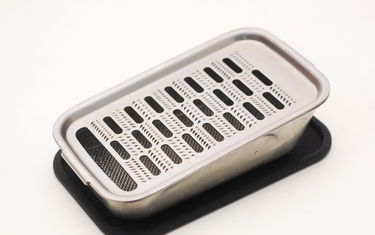Do you know "Daikon oroshi"?
Daikon oroshi is grated daikon (Japanese white radish) and specific to Japan. It isn’t eaten alone but with grilled fish, soba, udon, Japanese rolled Tamagoyaki omelette, and hotpot. It is piquant and adds refreshing flavor to the dishes. It is also nutritious with adequate enzymes. It is a common condiment either at home or at restaurants in Japan.
In fact, the taste and flavor of daikon oroshi depends on how to grate it. If daikon oroshi you make tastes too pungent, it might be because of the way of grating. We would like to show you how to grate daikon well.
Conditions of Maiking Good Daikon Oroshi
There are 4 secrets to make tasty daikon oroshi as follows.
- The part of daikon to be used
- The quality of grater
- How to grate
- How to drain
We will explain in detail for each.
The part of daikon to be used
Different parts of daikon taste different. If divided into 3 parts, Upper (leaf side), Middle, Lower (root side), the Upper part is the best for making daikon oroshi as it tastes the least pungent. Basically, lower parts are more pungent. So, if you want less pungent daikon oroshi, use upper part and if you want more pungent daikon oroshi, use lower part.
Daikon skin has also pungent principles. So, peel off its skin in 5 to 8 mm thickness with a knife, not with a peeler. Now all the reparation is done!
The quality of grater
The quality of grater affects the outcome.

To grate finely is ideal for making fluffy daikon oroshi that has good texture when eaten. We use Tsuboe Finest Grater -hako- in this post.
This grater is equipped with four directional blades (quattro blades) that are manually made by professionals using chisels. It can fluffy daikon oroshi without effort.

How to Grate Daikon
First, it is important to grate gently in a circular motion. If you put too much strength, its fibers cannot be cut off properly and leave unpleasant textures. Also, it will result in being more pungent.
Next it should be grated just before eating as it gives off bad smell that is specific to Daikon over time.
How to Drain
After grating drain grated daikon moderately. If you drain too much, it will be dry and not taste good. If you do not drain, bitterness and astringency will remain. Drain it gently as if holding a baby’s hand.

As the strainer is attached to the grater, the water will be drained right after grating daikon. This grater is specifically designed to grate daikon. Also, the strainer exactly fits in the container under the grater. These are the best conditions for making fluffy authentic grated daikon.
Try Authentic Grated Daikon!
Eating grated daikon is a food culture specific to Japan. Not just grating, there are right procedures and reasons.
People who live outside Japan might not often eat grated daikon.
For those who pursue the authentic quality and taste, Tsuboe Finest Grater -hako- is strongly recommended. As it comes with a gift box, it is good for gift.













